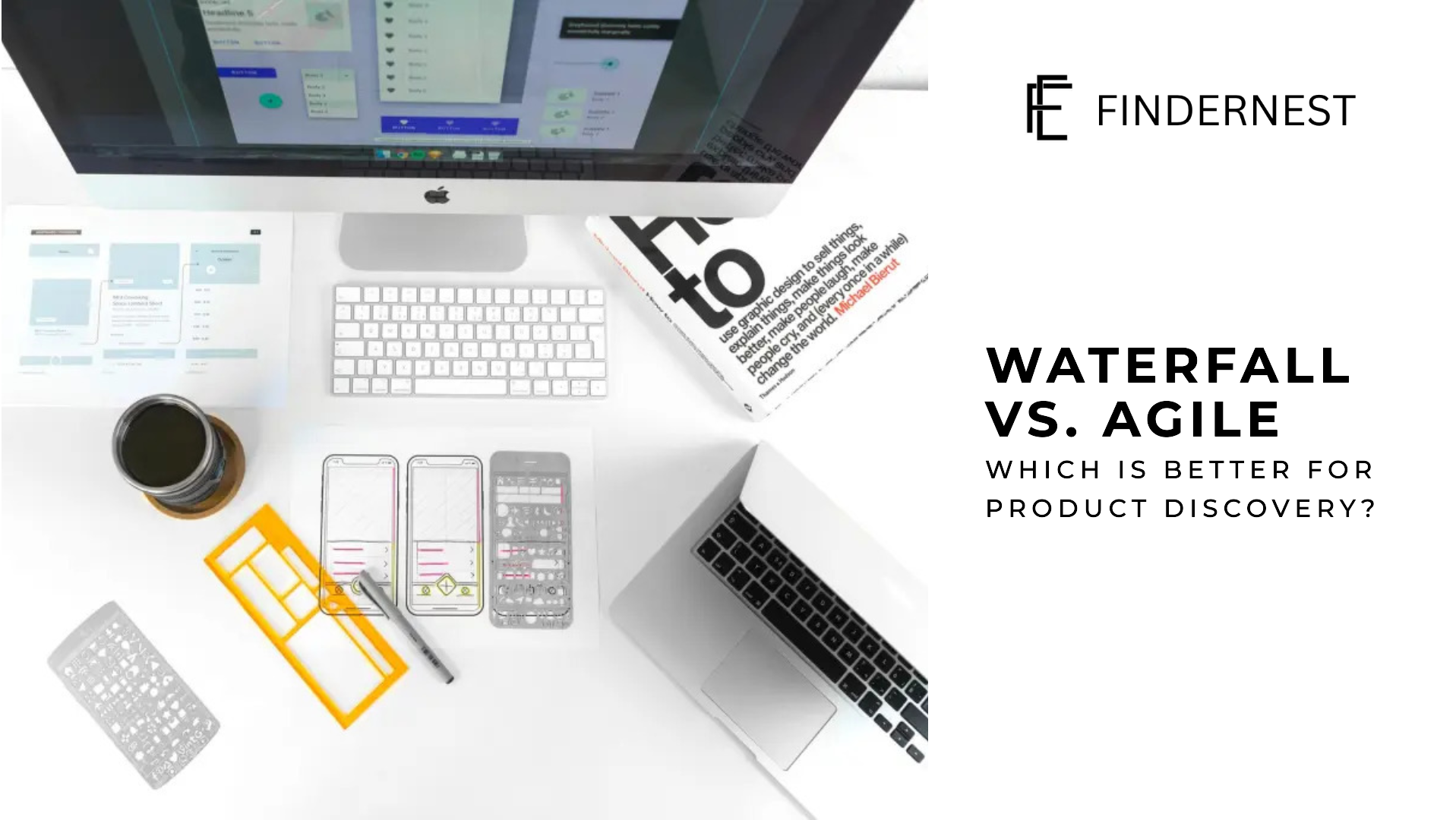Engineering | Agile | Operations | Business Consulting | Product Development | Software Development | Product Engineering | Waterfall
Waterfall vs. Agile: Which is Better for Product Discovery?
Read Time 11 mins | Written by: Praveen Gundala

Delve into the strengths and weaknesses of Waterfall and Agile methodologies within the realm of product discovery to determine the most effective approach. At Findernest, we excel in selecting the optimal discovery strategy to ensure the timely and budget-friendly delivery of top-notch software products. Elevate your projects with our expert software engineering and tech consulting services, tailored to guarantee excellence and innovation amidst evolving regulations, all while aligning with your business objectives.
Understanding the Fundamentals of Waterfall and Agile Methodologies
Waterfall and Agile stand out as prominent project management methodologies, each offering a distinct approach to product discovery. The Waterfall methodology follows a linear and sequential path, where each phase must be completed before the next one can begin, encompassing structured stages like requirements, design, implementation, verification, and maintenance.
In contrast, Agile takes on an iterative and incremental approach, emphasizing flexibility and collaboration with customers. Agile methodologies, including Scrum and Kanban, break down projects into smaller, manageable chunks known as sprints or iterations. This enables teams to continuously adapt and refine their product based on ongoing feedback and evolving requirements.
The product discovery phase plays a crucial role in ensuring that the right problem is being solved in the right way for the right audience. It serves as the foundation for accurate project time and budget estimates. Inadequate planning remains a key reason for IT projects spiralling out of control, with studies indicating defects in 40% to 50% of software products stemming from this. Budget and schedule overruns are also common pitfalls, along with projects that meet deadlines and budgets but fail to deliver a product that resonates with users. Regardless of the software or feature being developed, a robust product discovery process is always essential.
Product discovery in Waterfall

Extensive research, analysis, and documentation efforts are essential during this stage, making it a time-consuming process. Depending on the complexity of your project, it can last between four to eight weeks or even longer and can account for a significant portion of your budget, typically ranging from 10-15% of the total project costs. During the product discovery phase in the waterfall model, you engage in discussions, interviews, questionnaires, focus groups, observations, and interface analysis to uncover the requirements for your software system.
- Getting a deep understanding of the business context, business model, objectives, and risks
- Determining the product vision and scope aligned with the business objectives
- Identifying success metrics
- Identifying and classifying users
- Understanding user needs and pain points
- Determining how users will interact with the system
- Resolving conflicting requirements
- Determining how the system will meet user needs and business objectives
- Identifying functional and non-functional requirements
- Prioritizing requirements
- Uncovering risks, uncertainties, and possible roadblocks
After the product discovery process is completed, you have valuable deliverables serving as the springboard to kick off software development.
The deliverables usually include:
1. Project Scope & Vision Statement. This document outlines a product concept and incorporates a scope part, covering:
- Business description, opportunities, needs, goals, success metrics, and risks
- Project scope is broken down into initial release and subsequent releases, and system limitations and exclusions
- Stakeholder profiles, project priorities, and deployment considerations
Product discovery in Agile

Software product discovery in Agile runs in parallel with the delivery track.
In contrast to the waterfall method, Agile focuses on swiftly validating ideas through experiments and user feedback. This approach guides the team in prioritizing product increments for development, testing, improvement, and bug fixes in upcoming iterations. By estimating smaller tasks, complexities and risks are minimized, resulting in expedited development processes.
But how do you get started in Agile?
In agile, a software development project often begins with pre-Sprint 1 activities that are waterfallish in nature and are known as Sprint 0 or the Inception Phase. Unlike in the waterfall strategy, this pre-planning, which we will call for convenience Sprint 0, is short. It takes a couple of weeks or less. The key objective of Sprint 0 is to get a grasp of the problem, develop a high-level understanding of the solution, and prepare for Sprint 1.
Normally, Sprint 0 activities include:
- Identifying a high-level product vision
- Exploring the system’s scope, including a high-level software architecture
- Identifying and prioritizing an initial product backlog, which is a list of work on the deck for the development team to complete
- Defining non-functional requirements (security, performance, scalability, etc.)
- Identifying the required skill sets for assembling the team
- Defining roles and responsibilities
- Estimating the team’s velocity (the amount of work that can be completed in each iteration)
- Identifying project risks
- Planning an initial roadmap based on the product backlog, velocity estimates, and dependencies
- Defining your Definition of Done (DoD)
- Defining a software testing strategy for the project
- Agreeing on, and setting up, reporting and progress-tracking tools
- Setting up technical infrastructure and development environments
- Preparing initial low-fidelity prototypes and wireframes
- Prioritized initial product backlog, including low-fidelity prototypes and wireframes, if applicable
- A high-level software architecture
- Defined DoD
- Project risk strategy and mitigation plan
- Ready-to-go project infrastructure and tools
- High-level definition of non-functional requirements
- Defined test strategy
- Team setup
Discovery track
Product discovery in agile normally runs one or two iterations ahead of the development track, with the same, cross-functional team doing the two tracks in parallel. The discovery track can be broken down as follows:
- Understanding and defining the problem
- Identifying, prototyping, and testing a solution
Evaluating the Impact of Waterfall on Product Discovery
The Waterfall methodology's linear nature can be both a strength and a weakness in product discovery. On the one hand, its structured stages ensure that thorough documentation and planning are completed before development begins. This can lead to a clear and well-defined scope, reducing the risk of scope creep.
However, the rigidity of Waterfall can also hinder the product discovery process. Since changes are difficult to implement once a phase is completed, teams may struggle to adapt to new insights or market shifts. This can result in products that are misaligned with customer needs or market demands by the time they are launched.
The Advantages of Agile for Product Discovery
Agile methodologies offer several advantages for product discovery, primarily through their emphasis on flexibility and customer feedback. By working in short sprints, Agile teams can quickly iterate on their product, incorporating feedback and making adjustments as needed. This iterative process helps ensure that the final product is more closely aligned with customer needs and market demands.
Additionally, Agile's collaborative nature fosters better communication and collaboration among team members and stakeholders. This can lead to a more innovative and responsive product discovery process, as ideas and feedback are continuously exchanged and integrated.
Comparative Analysis: Waterfall vs. Agile in Real-World Scenarios
In real-world scenarios, the choice between Waterfall and Agile can significantly impact the success of product discovery. For example, industries with strict regulatory requirements, such as healthcare and aerospace, may benefit from Waterfall's structured approach to ensure compliance and thorough documentation.
On the other hand, technology and software development industries often prefer Agile due to its ability to quickly adapt to changing requirements and incorporate user feedback. Companies like Spotify and Google have successfully utilized Agile methodologies to innovate and stay ahead in the competitive tech landscape.
- Your product vision. If your product vision is not final, there’s no other way around but to go with agile discovery. For instance, you may be nurturing an idea about an innovative product, meaning there are too many unknowns to plan the entire project. Alternatively, you may have only a vague idea of what your product should be and want to test and validate as many hypotheses as possible. Or, the efficiency of your software would highly depend on end-users' feedback, which you then need to collect as your product evolves.
- Your project scope. You should also opt for agile discovery if you want to be flexible with your project scope. Agile welcomes changing requirements even late in development, allowing you to improve initially planned features or add new use cases when, for instance, updated data on user needs arrives. But Heaven forbid a requirement change in the waterfall. Redoing all the planning or even a ready piece of software (and testing along the way) will cost you both precious time and money.
- Project complexity. The waterfall strategy will be your right choice if your company needs thorough and detailed project documentation because of compliance issues presented by a highly regulated industry or internal policies and procedures. It also makes sense to set money and time aside for a massive product discovery phase, if your product is too complex and will need integration with a lot of external systems.
- Time constraints. If you want to hit the market as quickly as possible, skipping the lengthy planning stage and going with agile discovery will be a better strategy.
- Your budget, too. Sometimes, a company just doesn’t want or doesn’t have the budget to spend on massive planning activities. With limited funds available, giving away 10% of the budget before you’ve hardly started fleshing out your project, will likely mean saving on functionality. So, agile will be your go-to option here.
Choosing the Right Methodology for Your Project’s Success
Selecting the right methodology for your project depends on various factors, including the project's complexity, regulatory requirements, and the need for flexibility. If your project requires a well-defined scope and extensive documentation, Waterfall may be the better choice. However, if adaptability and customer feedback are critical to your project's success, Agile is likely the more suitable option.
Ultimately, the best approach may involve blending elements of both methodologies to create a hybrid model that leverages the strengths of each. By understanding the unique advantages and limitations of Waterfall and Agile, you can make an informed decision that aligns with your project's goals and maximizes the effectiveness of your product discovery process.
Learn how FindErnest is making a difference in the world of business
Praveen Gundala
Praveen Gundala, Founder and Chief Executive Officer of FindErnest, provides value-added information technology and innovative digital solutions that enhance client business performance, accelerate time-to-market, increase productivity, and improve customer service. FindErnest offers end-to-end solutions tailored to clients' specific needs. Our persuasive tone emphasizes our dedication to producing outstanding outcomes and our capacity to use talent and technology to propel business success. I have a strong interest in using cutting-edge technology and creative solutions to fulfill the constantly changing needs of businesses. In order to keep up with the latest developments, I am always looking for ways to improve my knowledge and abilities. Fast-paced work environments are my favorite because they allow me to use my drive and entrepreneurial spirit to produce amazing results. My outstanding leadership and communication abilities enable me to inspire and encourage my team and create a successful culture.

